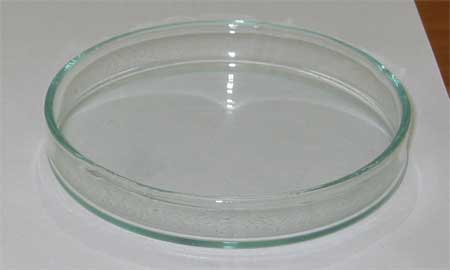As in similar cases in the history of science, did Petrie 'draw' his invention from scientists working in Britain?

Julius Richard Petri (May 31, 1852 – December 20, 1921) was a German bacteriologist known for inventing Petri dishes while working as Robert Koch's assistant.
Petrie studied medicine at the Kaiser Wilhelm Academy of Military Medicine (1871-1875) and received his medical degree in 1876. He continued his studies at the Charité Hospital in Berlin and served in active combat duty as a military doctor until 1882, and continued as a reservist.
Between the years 1877-9 he was attached to the Imperial Ministry of Health in Berlin, where he became Robert Koch's assistant. On the advice of Angelina Hesse, the American wife of another of his assistants Walter Hesse, Koch's laboratory began to multiply bacteria on agar plates. Petri then invented the standard culture dish, or Petri dish, and developed the technology of the agar culture that was used to purify or clone bacterial colonies derived from a single cell. The development made it possible to identify the bacteria responsible for the disease being tested.
The Petri dish has become a very common tool in microbiology laboratories. It is usually made of glass or transparent plastic. It is round, shallow and has a flat bottom and perpendicular sides. It comes with a slightly larger lid than is suitable for covering the sides of the plate. Petri dishes contain agar or - a growth medium for bacteria made of gelatin and allows the preparation of cell cultures and microscopic organisms such as bacteria and yeast.
Koch's contribution was that he discovered that with the help of arranging the bacteria and growing them on agar it is possible to observe and identify and thus also differentiate between different strains of bacteria in one culture. He initially used gelatin spread on a smooth surface of glass. However, in 1887, Petrie upgraded the system and instead of a surface he switched to using a flat covered plate, the two of which turned it into the bone we know today.
However, it turns out that, as in all legends, this is also not accurate. A similar plate was developed by the Slovenian scientist Emanuel Klein (1844-1925) who worked and researched in England. Klein wrote a highly influential textbook in those days, Micro-organisms and Disease. In the third edition of the book, written in 1885, that is, two years before Petri's development, a very similar plate was described that Petri claimed to have invented.
And to complicate matters further, another English researcher named Percy Frankland published an article in 1886 in the Journal of the British Royal Society in which he described a very similar plate.
Whether it is a convergent technological evolution (a common thing in this field) or whether Klein and Fernland were robbed of their rightful place in the history of science by a laboratory more famous than theirs, we will never know.
In 1886, at the same time as his work in Koch's laboratory, he served as a curator at the Museum of Hygiene in Berlin and from 1889 a full member of the Kaiser Wilhelm Academy of Military Medicine from which he retired in 1900. At the end of his life he suffered from excess weight.
.

6 תגובות
Richard Petrie did not invent the plate named after him, but "imported" it from other laboratories to the famous laboratory of Robert Koch. Koch's publication actually caused the plate to be named after Petri.
Yael, even if the wording is not clear or there are several spelling errors, this situation does not cause the piece of writing to lose its meaning.
It may not be clear, he replaced the gelatin with agar, what I wrote is that before him gelatin was used. And of course thanks for drawing attention to the typo. I fixed it.
Some mistakes:
"It comes with a slightly larger lid than what is planted to cover the sides of the plate" - should be "the right one",
"He initially used gelatin that was spread on a smooth surface of glass" - should mean "that was spread".
Agar is not gelatin. The original growing medium was indeed gelatin, which is a protein produced from the bones and skin of animals that are used for the meat industry. Since the protein is unstable when heated, which is sometimes required to sterilize the substrate, they started using agar. Agar is a sugary compound produced by algae, and resistant to heating.
I assume you meant 161